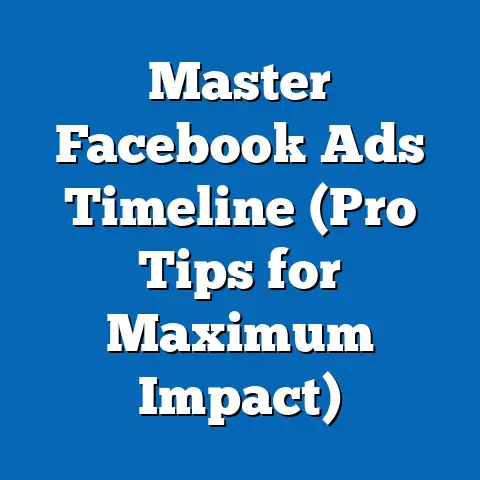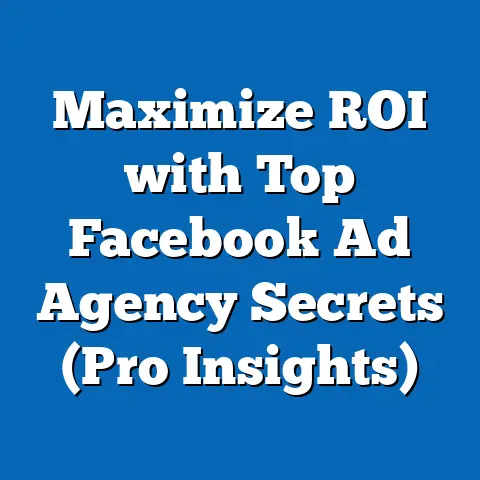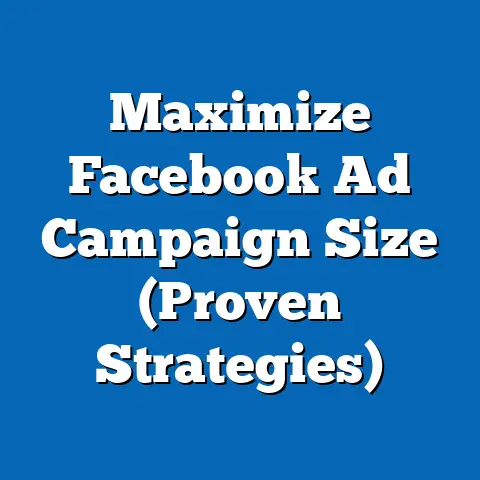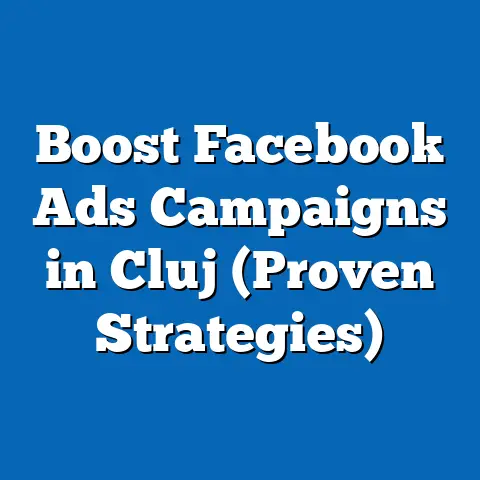Maximize Facebook Ads with Exclusion Strategies (Expert Insights)
Imagine launching a Facebook ad campaign, full of hope, only to see your budget drain away while reaching the wrong people. It’s a frustrating experience I’ve seen happen to countless businesses. But what if I told you there’s a powerful, often overlooked strategy that can dramatically improve your ROI?
We’re talking about exclusion strategies. They’re like the secret weapon in your Facebook advertising arsenal, allowing you to pinpoint exactly who not to target. In fact, businesses that intelligently use audience exclusion strategies can see an average increase of 20-30% in ROI compared to those who don’t. That’s a game-changer!
In this guide, I’m going to dive deep into the world of Facebook ad exclusion strategies. I’ll explain why they’re essential, how to implement them effectively, and share expert insights to help you maximize your ad spend and reach the right audience, every time.
Here’s what we’ll cover:
- Understanding the Basics of Facebook Ads: A quick refresher on audience targeting.
- The Power of Exclusion Strategies: Why excluding the wrong people is just as important as targeting the right ones.
- Expert Insights on Effective Exclusion Strategies: Real-world examples and actionable tips.
- Tools and Techniques for Implementing Exclusion Strategies: A step-by-step guide to using Facebook Ads Manager.
Let’s get started!
Understanding the Basics of Facebook Ads
Before we jump into the nitty-gritty of exclusion strategies, let’s make sure we’re all on the same page when it comes to Facebook advertising fundamentals. At its core, Facebook advertising is about connecting your message with the right people at the right time. Facebook offers a robust suite of targeting options, allowing you to define your ideal audience based on a multitude of factors.
These factors include:
- Demographics: Age, gender, location, education, relationship status, job title, and more.
- Interests: Hobbies, passions, and things people are interested in, as inferred from their Facebook activity.
- Behaviors: Past purchase behavior, device usage, travel habits, and other actions they take online.
- Connections: People who like your page, use your app, or attend your events.
- Custom Audiences: Lists of customers or prospects you upload to Facebook (hashed for privacy).
- Lookalike Audiences: Audiences that Facebook creates based on your existing customer data, finding people who share similar characteristics.
This granular targeting is incredibly powerful. Imagine I’m selling high-end organic dog food. I can target dog owners (interest), aged 25-55 (demographics), who have purchased pet supplies online in the past (behavior), and who are similar to my existing customers (lookalike audience). That’s pretty specific!
However, even with all these options, it’s easy to waste money if you’re not careful. That’s where audience exclusion comes in. It’s not enough to simply target the right people; you also need to avoid targeting the wrong people. This is about refining your targeting to ensure you’re only showing your ads to those who are most likely to convert.
Key Takeaway: Facebook’s powerful targeting options are a double-edged sword. They allow you to reach your ideal audience, but you also need to actively avoid wasting money on irrelevant users.
The Power of Exclusion Strategies
So, what exactly are exclusion strategies? Simply put, they’re the opposite of targeting. Instead of defining who you want to reach, you’re defining who you don’t want to reach. You’re telling Facebook, “Hey, don’t show my ads to these people, no matter what.”
This may seem counterintuitive at first. Why would you intentionally limit your reach? Because focusing on the right audience is key.
Think of it like this: you wouldn’t try to sell snow shovels in Miami, right? Even if you targeted “homeowners” in Miami, you’d be wasting your money on people who simply don’t need your product. Exclusion strategies allow you to apply that same logic to your Facebook ads, ensuring you’re not wasting ad spend on irrelevant users.
The power of exclusion lies in its ability to refine your targeting and improve your ROI. Here’s why it’s so important:
- Reduces Wasted Ad Spend: By excluding irrelevant users, you’re ensuring that your budget is spent on those who are most likely to convert.
- Improves Ad Relevance: Showing your ads to the right people increases the chances of engagement, clicks, and conversions.
- Reduces Ad Fatigue: Bombarding the same people with ads over and over again can lead to ad fatigue and negative brand perception. Exclusion strategies help you keep your audience fresh.
- Enhances Brand Perception: Showing relevant ads to the right people improves their perception of your brand.
- Optimizes Retargeting Campaigns: Exclude people who have already converted to focus on those who are still on the fence.
I remember working with a client who was running a retargeting campaign for an online course. They were retargeting everyone who had visited their website in the past 30 days. While the campaign was generating some sales, the ROI was lower than expected.
After analyzing the data, I realized they were retargeting people who had already purchased the course! By excluding those who had already converted, we significantly improved the campaign’s ROI. It was a simple change, but it made a huge difference.
The psychological aspect of audience exclusion is also worth considering. People are more likely to respond positively to ads that are relevant to their needs and interests. By excluding those who are unlikely to convert, you’re creating a more positive and engaging experience for your target audience.
Potential Risks of Not Using Exclusion Strategies:
- High Cost Per Acquisition (CPA): Wasted ad spend leads to a higher cost per conversion.
- Low Click-Through Rate (CTR): Irrelevant ads are less likely to be clicked on.
- Negative Brand Perception: Showing irrelevant ads can annoy potential customers.
- Ad Fatigue: Bombarding the same people with ads can lead to ad blindness.
- Reduced ROI: Ultimately, not using exclusion strategies can significantly reduce your return on investment.
Key Takeaway: Exclusion strategies are essential for maximizing your ad spend, improving ad relevance, and enhancing brand perception. Don’t waste money on irrelevant users!
Expert Insights on Effective Exclusion Strategies
Now that we understand the importance of exclusion strategies, let’s dive into some specific examples and expert insights.
1. Retargeting with Exclusions
Retargeting is a powerful tool for re-engaging website visitors and turning them into customers. However, it’s crucial to exclude those who have already converted. There’s nothing more annoying than seeing ads for a product you’ve already purchased.
Example: You’re running a retargeting campaign for an e-commerce store. Exclude customers who have completed a purchase in the past 30 days to focus on those who are still browsing.
Expert Insight: “Retargeting is incredibly effective, but it’s essential to segment your audience and exclude those who have already converted. This not only reduces wasted ad spend but also improves the customer experience,” says digital marketing expert Neil Patel.
How to Implement: Create a custom audience of customers who have completed a purchase (using website pixel data or customer list upload). Then, exclude this audience from your retargeting campaign.
2. Demographic Exclusions
Demographic data can be a valuable tool for refining your targeting. If your product or service is only relevant to a specific age group, gender, or location, consider excluding those who don’t fit the bill.
Example: You’re selling retirement planning services. Exclude users under the age of 40 to focus on those who are closer to retirement.
Expert Insight: “Demographic exclusions can be a simple yet effective way to improve your ad relevance. However, be careful not to make assumptions about your audience based solely on demographics. Always test your assumptions with data,” advises social media strategist Mari Smith.
How to Implement: In Facebook Ads Manager, go to the “Detailed Targeting” section and use the “Exclude” option to exclude specific age ranges, genders, or locations.
3. Interest-Based Exclusions
Excluding users based on interests can help you refine your targeting and reach a more receptive audience. This is particularly useful if your product or service is niche and not relevant to everyone.
Example: You’re selling vegan protein powder. Exclude users who are interested in “meat-based diets” or “bodybuilding” to focus on those who are already interested in plant-based nutrition.
Expert Insight: “Interest-based exclusions can be a powerful way to narrow your focus and reach a more qualified audience. Think about what interests might indicate that someone is not a good fit for your product or service,” suggests Facebook ads expert Jon Loomer.
How to Implement: In Facebook Ads Manager, go to the “Detailed Targeting” section and use the “Exclude” option to exclude specific interests.
4. Lookalike Audience Exclusions
Lookalike audiences are a great way to reach new potential customers who share similar characteristics with your existing customers. However, it’s often beneficial to exclude your existing customers from your lookalike audience campaigns.
Example: You’re running a lookalike audience campaign to find new customers for your subscription box service. Exclude your existing subscribers to avoid showing them ads for a product they already have.
Expert Insight: “Lookalike audiences are incredibly powerful, but it’s important to exclude your existing customers. You don’t want to waste ad spend showing ads to people who are already paying you,” says digital marketing consultant Amy Porterfield.
How to Implement: Create a custom audience of your existing customers (using customer list upload). Then, exclude this audience from your lookalike audience campaign.
5. Seasonal and Event-Based Exclusions
Certain times of the year or events can impact audience behavior. It’s important to consider these factors when planning your exclusion strategies.
Example: You’re running a campaign promoting Christmas decorations in January. Exclude users who are interested in “Christmas” or “holiday decorations” to avoid showing them irrelevant ads after the holiday season has passed.
Expert Insight: “Seasonal and event-based exclusions can help you keep your ads relevant and avoid wasting money on outdated campaigns. Pay attention to the calendar and adjust your targeting accordingly,” advises social media marketing expert Gary Vaynerchuk.
How to Implement: Use the “Detailed Targeting” section in Facebook Ads Manager to exclude users based on interests related to specific seasons or events.
My Own Experience: I once ran a campaign for a summer camp that targeted parents with children aged 6-12. The campaign was performing well, but I noticed a significant drop in engagement after the summer camp season ended. By excluding parents who had already registered their children for the camp, I was able to reallocate my budget to other marketing efforts.
Key Takeaway: Effective exclusion strategies require a deep understanding of your target audience and their behavior. Don’t be afraid to experiment and test different exclusions to see what works best for your business.
Tools and Techniques for Implementing Exclusion Strategies
Now that we’ve covered the theory behind exclusion strategies, let’s get practical. Here’s a step-by-step guide to implementing them in Facebook Ads Manager:
- Identify Your Target Audience: Before you can exclude anyone, you need to have a clear understanding of who you want to reach. Define your ideal customer based on demographics, interests, behaviors, and other relevant factors.
- Identify Potential Exclusions: Think about who you don’t want to reach. Consider factors such as:
- Customers who have already converted
- Users who are not interested in your product or service
- Demographics that are not relevant to your target audience
- Users who have already seen your ads too many times
- Create Custom Audiences: Use Facebook’s custom audience feature to create lists of users you want to exclude. You can create custom audiences based on:
- Website traffic (using the Facebook pixel)
- Customer lists (email addresses, phone numbers)
- App activity
- Engagement on Facebook (page likes, video views, event attendance)
- Implement Exclusions in Ads Manager: When creating or editing your ad set, go to the “Audience” section. Under “Detailed Targeting,” you’ll see an option to “Exclude.” Click on this option and select the custom audiences you want to exclude from your campaign.
- Monitor Performance: Keep a close eye on your ad performance and make adjustments as needed. Track metrics such as:
- Cost Per Acquisition (CPA)
- Click-Through Rate (CTR)
- Conversion Rate
- Return on Ad Spend (ROAS)
- A/B Test Your Exclusions: Experiment with different exclusion strategies to see what works best for your business. For example, you could test excluding different age ranges or interests.
- Customers who have already converted
- Users who are not interested in your product or service
- Demographics that are not relevant to your target audience
- Users who have already seen your ads too many times
- Website traffic (using the Facebook pixel)
- Customer lists (email addresses, phone numbers)
- App activity
- Engagement on Facebook (page likes, video views, event attendance)
- Cost Per Acquisition (CPA)
- Click-Through Rate (CTR)
- Conversion Rate
- Return on Ad Spend (ROAS)
Tips for Analyzing Performance Metrics:
- Look for Patterns: Identify any trends in your data that might suggest specific exclusions are working well.
- Segment Your Data: Analyze your data by demographic, interest, and other factors to identify areas for improvement.
- Use Attribution Models: Understand how different touchpoints are contributing to your conversions.
- Track Your ROI: Ultimately, the most important metric is your return on investment. Make sure your exclusion strategies are helping you generate a positive ROI.
Emerging Technologies and Trends:
- AI-Powered Targeting: AI is becoming increasingly sophisticated at identifying and targeting the right users. Look for tools that can help you automate your exclusion strategies using AI.
- Privacy-Focused Targeting: As privacy regulations become stricter, it’s important to use targeting methods that respect user privacy. Consider using contextual targeting or first-party data instead of relying solely on third-party data.
Key Takeaway: Implementing exclusion strategies in Facebook Ads Manager is a straightforward process. By following these steps and monitoring your performance, you can significantly improve your ROI.
Conclusion
Facebook advertising is a powerful tool for reaching your target audience and growing your business. However, it’s essential to use exclusion strategies to maximize your ad spend and ensure that your ads are reaching the right people. By excluding irrelevant users, you can improve your ad relevance, reduce ad fatigue, and enhance brand perception.
In this guide, I’ve covered the basics of Facebook ads, the power of exclusion strategies, expert insights on effective exclusions, and the tools and techniques for implementing them in Facebook Ads Manager. Remember, the key to success is to understand your target audience, experiment with different strategies, and monitor your performance closely.
As the digital advertising landscape continues to evolve, data-driven strategies will become even more critical. By embracing exclusion strategies, you can stay ahead of the curve and maximize the effectiveness of your Facebook ads.
So, go ahead and start implementing exclusion strategies in your Facebook campaigns today. You’ll be amazed at the difference it can make!
Next Steps:
- Review your existing Facebook campaigns and identify potential exclusions.
- Create custom audiences based on your customer data and website traffic.
- Implement exclusion strategies in your ad sets and monitor your performance.
- Stay up-to-date on the latest Facebook advertising features and best practices.
By taking these steps, you can unlock the full potential of Facebook advertising and achieve your business goals. Good luck!






